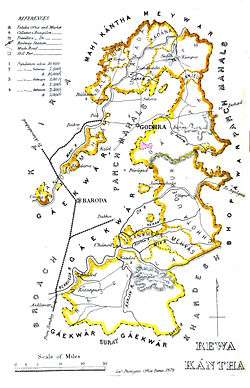Rewa Kantha Agency
| Rewa Kantha Agency | |||||
| Agency of British India | |||||
| |||||
 | |||||
| History | |||||
| • | Established | 1811 | |||
| • | Formation of the Baroda and Gujarat States Agency | 1937 | |||
| Area | |||||
| • | 1901 | 12,877 km2 (4,972 sq mi) | |||
| Population | |||||
| • | 1901 | 479,065 | |||
| Density | 37.2 /km2 (96.4 /sq mi) | ||||
| | |||||
| Princely state |
|---|
| Individual residencies |
| Agencies |
|
| Lists |
|
Rewa Kantha was a political agency of British India, managing the relations (indirect rule) of the British government's Bombay Presidency with a collection of princely states. It stretched for about 150 miles between the plain of Gujarat and the hills of Malwa, from the Tapti River to the Mahi River crossing the Narmada or Rewa River, from which it takes its name.[1]
The political agent, who was also collector of the prant (British District) of the Panchmahal, resided at Godhra.
History
The native states came under British subsidiary alliances after the Third Anglo-Maratha War of the early 19th century.[2]
In 1937 the princely states of the Rewa Kantha Agency were merged with Baroda State in order to form the Baroda and Gujarat States Agency,[3] which in turn merged in 1944 with the Western India States Agency as Baroda, Western India and Gujarat States Agency.
After the Independence of British India in 1947, split into India and Pakistan, the rulers of the states all agreed to accede to the Government of India and were integrated into Bombay State. Bombay state was split along linguistic lines in 1960, and Rewa Kantha became part of Gujarat, like Saurashtra State.
Princely States
The number of separate states was 61, mostly minor or petty states except for five. Many of them were under British influence; the largest one was Rajpipla.[4]
The Agency also dealt with five second-class states named Chhota Udaipur State, Devgadh Bariya State, Santrampur, Lunawada State and Balasinor State. The total area of the states the agency related to was 12,877 km2 (4,972 sq mi). In 1901 their population was 479,065. Many of the inhabitants were Bhils and Kolis.[5]
Rewa Kantha division
(in direct relations with the Political Agent at Godhra)
- Rajpipla (Nandod), First Class, title Maharaja, Hereditary salute of 13-guns
- Bari(y)a (Devgadh), Second Class, title Maharaol, Hereditary salute of 9-guns (11-guns personal)
- Lunavada, Second Class, title Maharana, Hereditary salute of 9-guns
- Balasinor, Second Class, title Nawab, Hereditary salute of 9-guns
- Sant (Sunth) (Rampur), Second Class, title Raja, Hereditary salute of 9-guns
Non-salute states :
- Chhota Udehpur (Mohan), Second Class
- Kadana, Third Class
- Sanjeli, Third Class
- Jambughoda (Narukot), Third Class
Mehwas
Only non-salute states: petty rural (e)states
Sankheda
(near Narmada River)
- Mandwa, Third Class (personal) / Fourth Class
- Gad Boriad, Third Class (personal) / Fourth Class
- Shanor, Fourth Class
- Vajiria, Fourth Class
- Vanmala, Fourth Class (personal) / Fifth Class
- Nangam, Fifth Class
- Naswadi,
- Uchad,
- Agar,
- Palasni,
- Bhilodia :
- Motisinghji,
- Chhatarsinghji,
- Vasan Virpur,
- Vo(h)ra,
- Vasan Sewada,
- Alwa,
- Chorangla,
- Sindiapura,
- Bihora,
- Vadia (Virampura),
- Dudhpur,
- Rampura,
- Jiral Kamsoli,
- Chudesar,
- Pantalavdi :
- Akbar Khan,
- Kesar Khan,
- Regan,
- Nalia,
Pandu
(near Mahi River; all paying tribute to the Gaekwar Baroda State) :
- Bhadarwa, Third Class
- Umetha, Third (personal) / Fourth Class
- Sihora, Fourth Class
- Pandu, Fifth Class
- the Donka (e)states
- Dodka,
- Angadh,
- Rayka,
Postal Stamps
In addition to those of Rewa Kantha itself, revenue and/or court fee stamps were issued for the following states:
- in the Rewa Kantha Division (all)
- Rajpipla
- Balasinor
- Baria
- Lunavada
- Sant
- Chhota Udaipur
- Jambughoda
- Kadana
- Sanjeli
- in the Sankheda Mehwas (only these)
- Gad Boriad
- Naswadi
- Shanor
- Vajiria
- in the Pandu Mehwas (only these)
- Bhadarva
- Pandu Mewas
- Umeta
- Bakrol (Boru)
See also
References
- ↑ "Gazetteer of the Bombay Presidency"
- ↑ Historical Sketch of the Native States of India. 1875
- ↑ History of the State of Gujarat
- ↑ Princely States within the Rewa Kantha Agency (1901)
- ↑ "The Rewakantha directory"